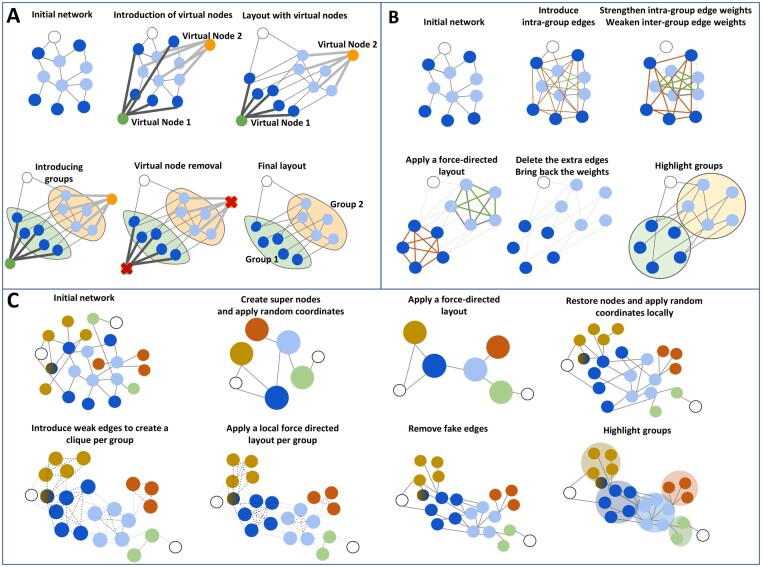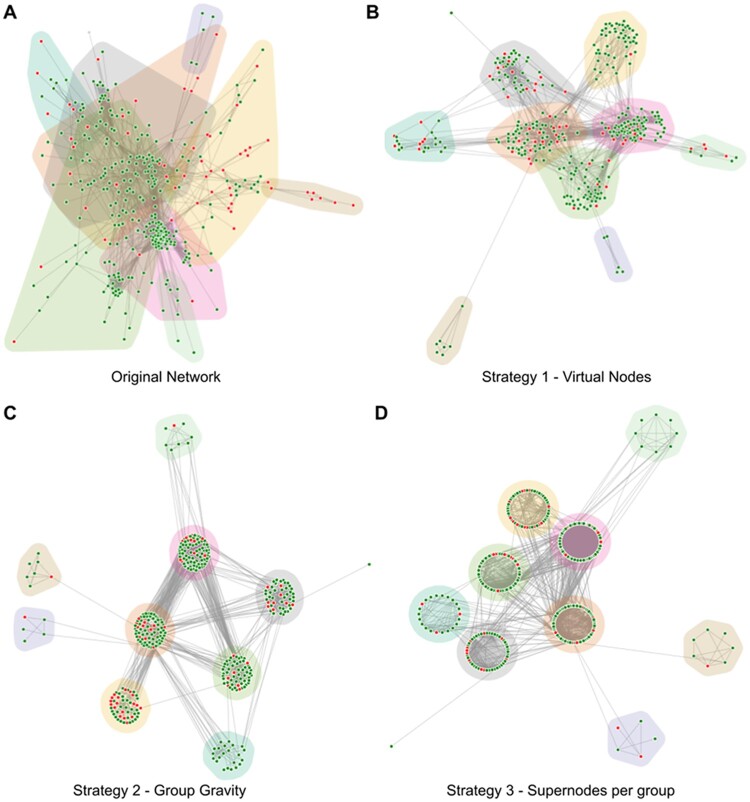Abstract
Motivation
Network biology is a dominant player in today’s multi-omics era. Therefore, the need for visualization tools which can efficiently cope with intra-network heterogeneity emerges.
Results
NORMA-2.0 is a web application which uses efficient layouts to group together areas of interest in a network. In this version, NORMA-2.0 utilizes three different strategies to make such groupings as distinct as possible while it preserves all of the properties from its first version where one can handle multiple networks and annotation files simultaneously.
Availability and implementation
The web resource is available at http://norma.pavlopouloslab.info/. The source code is freely available at https://github.com/PavlopoulosLab/NORMA.
Network visualization is important to capture patterns and understand the associations among various biomedical entities coming from different repositories (Baltoumas et al., 2021; Koutrouli et al., 2020). To this end, several visualization tools have been proposed (Gehlenborg et al., 2010). However, despite their richness in the interactivity and variety of analysis options they offer (e.g. Cytoscape’s apps (Saito et al., 2012)), only few of them such as Cytoscape (Shannon et al., 2003) or Arena3Dweb (Karatzas et al., 2021) can cope with node heterogeneity. What is more, most of these tools focus mainly on interactivity, layout and network exploration and lack efficiency in effectively visualizing network annotations. To alleviate this issue, we developed the Network Makeup Artist (NORMA) application. NORMA is able to handle multiple networks and annotations simultaneously and produce high-quality, publication-ready visualizations. It also supports interactive network annotation visualization, topological analysis and automated community detection with various algorithms.
In this article, we present NORMA-2.0, a major update of the original NORMA application (Koutrouli et al., 2021) which now incorporates three different layout strategies to make annotated groups or areas of interest in a network more visually distinct. This way, NORMA-2.0 offers options for more appealing representations and enables a more targeted knowledge extraction and storytelling.
NORMA is a handy web tool for interactive network annotation, visualization and topological analysis through which users are able to handle multiple networks and annotations simultaneously. It offers group highlighting with the use of shaded areas (convex hulls) or pie-chart-like nodes while it comes with a functionality for directly comparing several networks topologically as well as different group annotations for the same network. In addition, users can perform clustering analysis on-the-fly and highlight nodes using any custom color scheme (e.g. expression values).
In this version, NORMA-2.0 utilizes three different strategies to visually separate annotated areas of interest in a network in combination with established layout algorithms, offered by igraph (Csardi and Nepusz, 2006). NORMA-2.0 is written in R/Shiny. Network visualization is offered by d3.js. The 3D network and convex hull visualizations are offered by plotly.
Strategy 1—Virtual nodes: As in the original version, NORMA-2.0 introduces one virtual node per group which behaves as a hub. Upon creation, edges with heavy weights are assigned to this node, linking it with all nodes from the same group. Then, any traditional layout algorithm can be utilized until it converges. The difference compared to directly applying a layout algorithm on the network is that the virtual nodes will attract the group-specific nodes as if they were parts of the network. After completing the layout execution, all virtual nodes are removed (Fig. 1A).
Fig. 1.
TThree different layout strategies to highlight areas of interest within a network and make them as distinct as possible. (A) Strategy 1: virtual nodes. (B) Strategy 2: Gravity. (C) Strategy 3: super nodes
Strategy 2— Gravity: Here, NORMA-2.0 introduces intra-group edges where necessary to generate clique-like subnetworks (all-vs-all connections). As a second step, the intra-group edge weights are significantly increased whereas the inter-group edge weights are simultaneously decreased. Then, any of the offered layouts can be applied to adjust node coordinates. The introduced edges and weights only exist for the calculation of the layout coordinates, and do not carry over to the final visualized network (Fig. 1B).
Strategy 3—Super nodes: In this scenario, NORMA-2.0 introduces ‘super-nodes’ to represent each of the uploaded annotation groups. Then, it connects these groups with edges which correspond to the connections from the initial network. For example, if node A belonging to the annotation Group 1 is connected to node B from Group 2, then the Group 1 super-node will also be connected to the Group 2 super-node. Notably, the network becomes significantly smaller both in terms of node and connection numbers. In a second step, any of the available layouts can be applied on the ‘super-network’. Upon layout convergence, all centroid coordinates of these super-nodes as well as the coordinates of no-group nodes can be further repelled according to a user-defined input. Then, all initial nodes will be placed around their respective super-nodes according to a second user-selected local layout choice. If a node belongs to more than one group, the average values for their (x, y) coordinates are used for the final visualization (Fig. 1C).
To showcase the capabilities of NORMA-2.0, we use the Drosophila Tau protein–protein interaction network (Fig. 2), based on experimental evidence from (Papanikolopoulou et al., 2019) and described in detail in (Koutrouli et al., 2021). Briefly, the network consists of 358 differentially expressed proteins from Drosophila Null-Tau mutants connected by 3176 edges, with each node colored based on its expression evidence (green for up-regulated, red for down-regulated). Network clustering was performed using the Louvain algorithm (Blondel et al., 2008) based on its topology, and the resulting communities are modeled as network groups. Compared to the original network or the virtual nodes strategy (Fig. 2A and B), the application of NORMA-2.0’s novel layout modification strategies (Fig. 2C and D) can result in more comprehensive views, in which the different community groups are easier to detect and visualize. Especially in the case of using supernodes (Strategy 3), the ability to use a local layout alongside the global network layout produces a well-defined, aesthetically pleasing visualization.
Fig. 2.
Visualization of the Drosophila Tau network in NORMA-2.0, using a force-directed layout. (A) The original network with no layout modifications. (B), Application of strategy 1 (virtual nodes). (C) Application of strategy 2 (group gravity). (D) Application of strategy 3 (supernodes). A force-directed layout is used for the global network, while a local circular layout is used for each group
We present NORMA-2.0, an update to the original NORMA network visualization platform that implements novel visualization strategies and improvements to its performance and utility. The main strength of NORMA-2.0, compared to its previous iteration and other network visualization platforms is ease of use, as well as the automated generation of appealing network visualizations based on user-provided annotations. While complex network views, such as those described, can be rendered with various tools (e.g. through Cytoscape’s advanced Filtering tab), their creation can be time-consuming and complex, particularly for inexperienced users. Conversely, NORMA-2.0 can produce high-quality, publication-ready network views with minimal input in the form of simple, easy to create annotation files. Overall, we believe that NORMA-2.0 is a handy tool for fast and high-quality, complex network visualization, designed for beginners as well as experts.
Contributor Information
Evangelos Karatzas, Institute for Fundamental Biomedical Research, Biomedical Sciences Research Center “Alexander Fleming”, Vari, 16672, Greece.
Mikaela Koutrouli, Novo Nordisk Foundation Center for Protein Research, Faculty of Health and Medical Sciences, University of Copenhagen, Copenhagen, Denmark.
Fotis A Baltoumas, Institute for Fundamental Biomedical Research, Biomedical Sciences Research Center “Alexander Fleming”, Vari, 16672, Greece.
Katerina Papanikolopoulou, Epigenetics and Cell Fate, CNRS UMR7216, Université Paris Cité, F-75013 Paris, France.
Costas Bouyioukos, Epigenetics and Cell Fate, CNRS UMR7216, Université Paris Cité, F-75013 Paris, France.
Georgios A Pavlopoulos, Institute for Fundamental Biomedical Research, Biomedical Sciences Research Center “Alexander Fleming”, Vari, 16672, Greece; Center for New Biotechnologies and Precision Medicine, School of Medicine, National and Kapodistrian University of Athens, 11527 Athens, Greece.
Funding
We would like to acknowledge support from the Hellenic Foundation for Research and Innovation (H.F.R.I) under the ‘First Call for H.F.R.I Research Projects to support faculty members and researchers and the procurement of high-cost research equipment grant’, Grant ID: 1855-BOLOGNA. G.A.P. was also supported by the project ‘The Greek Research Infrastructure for Personalised Medicine (pMedGR)’ (MIS 5002802), which is implemented under the Action ‘Reinforcement of the Research and Innovation Infrastructure’, funded by the Operational Program ‘Competitiveness, Entrepreneurship and Innovation’ (NSRF 2014-2020) and co-financed by Greece and the European Union (European Regional Development Fund). Finally, this article was partially funded by the Greek matching funds for the Marie Skłodowska-Curie Individual Fellowships Grant—MSCA-IF-EF-CAR (Grant ID: 838018-H2020-MSCA-IF-2018).
Conflict of Interest: none declared.
References
- Baltoumas F.A. et al. (2021) Biomolecule and bioentity interaction databases in systems biology: a comprehensive review. Biomolecules, 11, 1245. [DOI] [PMC free article] [PubMed] [Google Scholar]
- Blondel V.D. et al. (2008) Fast unfolding of communities in large networks. J. Stat. Mech., 2008, P10008. [Google Scholar]
- Csardi G., Nepusz T. (2006) The igraph software package for complex network research. Int. J. Complex Syst., 1695, 1–9. [Google Scholar]
- Gehlenborg N. et al. (2010) Visualization of omics data for systems biology. Nat. Methods, 7, S56–S68. [DOI] [PubMed] [Google Scholar]
- Karatzas E. et al. (2021) Arena3Dweb: interactive 3D visualization of multilayered networks. Nucleic Acids Res., 49, W36–W45. [DOI] [PMC free article] [PubMed] [Google Scholar]
- Koutrouli M. et al. (2020) A guide to conquer the biological network era using graph theory. Front. Bioeng. Biotechnol., 8, 34. [DOI] [PMC free article] [PubMed] [Google Scholar]
- Koutrouli M. et al. (2021) NORMA: the network makeup artist—a web tool for network annotation visualization. Genomics Proteomics Bioinformatics, S1672-0229(21)00130-3. [DOI] [PMC free article] [PubMed] [Google Scholar]
- Papanikolopoulou K. et al. (2019) Drosophila tau negatively regulates translation and olfactory long-term memory, but facilitates footshock habituation and cytoskeletal homeostasis. J. Neurosci., 39, 8315–8329. [DOI] [PMC free article] [PubMed] [Google Scholar]
- Saito R. et al. (2012) A travel guide to cytoscape plugins. Nat. Methods, 9, 1069–1076. [DOI] [PMC free article] [PubMed] [Google Scholar]
- Shannon P. et al. (2003) Cytoscape: a software environment for integrated models of biomolecular interaction networks. Genome Res., 13, 2498–2504. [DOI] [PMC free article] [PubMed] [Google Scholar]




